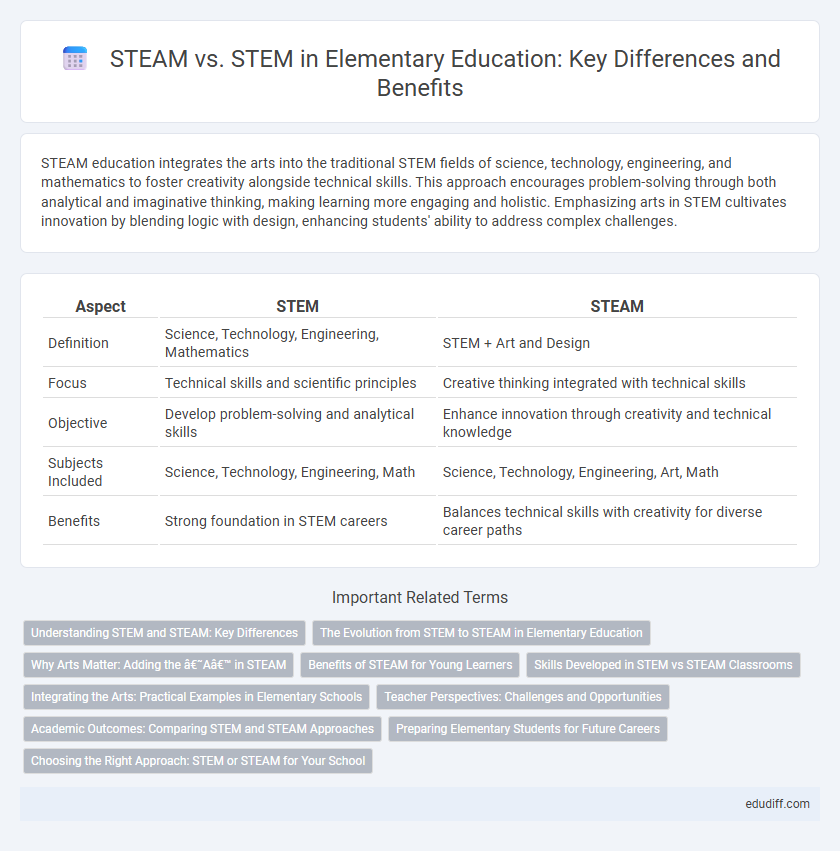STEAM education integrates the arts into the traditional STEM fields of science, technology, engineering, and mathematics to foster creativity alongside technical skills. This approach encourages problem-solving through both analytical and imaginative thinking, making learning more engaging and holistic. Emphasizing arts in STEM cultivates innovation by blending logic with design, enhancing students' ability to address complex challenges.
Table of Comparison
| Aspect | STEM | STEAM |
|---|---|---|
| Definition | Science, Technology, Engineering, Mathematics | STEM + Art and Design |
| Focus | Technical skills and scientific principles | Creative thinking integrated with technical skills |
| Objective | Develop problem-solving and analytical skills | Enhance innovation through creativity and technical knowledge |
| Subjects Included | Science, Technology, Engineering, Math | Science, Technology, Engineering, Art, Math |
| Benefits | Strong foundation in STEM careers | Balances technical skills with creativity for diverse career paths |
Understanding STEM and STEAM: Key Differences
STEM education focuses on Science, Technology, Engineering, and Mathematics to build strong technical skills essential for problem-solving and innovation. STEAM adds Art to these core subjects, encouraging creativity and critical thinking alongside scientific knowledge. This integration helps students develop both logical reasoning and imaginative design abilities, preparing them for diverse real-world challenges.
The Evolution from STEM to STEAM in Elementary Education
The evolution from STEM to STEAM in elementary education reflects a growing emphasis on integrating the arts with science, technology, engineering, and mathematics to foster creativity alongside analytical skills. This approach enhances student engagement by encouraging imaginative problem-solving and critical thinking through interdisciplinary learning. Research shows that incorporating the arts improves motivation and academic achievement in STEM subjects for young learners.
Why Arts Matter: Adding the ‘A’ in STEAM
Integrating the Arts into STEM education transforms it into STEAM, emphasizing creativity, critical thinking, and innovation. The Arts cultivate communication skills and emotional intelligence, essential for problem-solving and collaboration in science and technology fields. Research shows STEAM initiatives boost student engagement, making learning more inclusive and fostering well-rounded skill development.
Benefits of STEAM for Young Learners
STEAM education integrates art with science, technology, engineering, and math, fostering creativity and critical thinking in young learners. This approach enhances problem-solving skills and encourages innovative thinking by allowing children to express ideas through multiple disciplines. Including art helps students develop stronger communication abilities and emotional intelligence, preparing them for diverse future challenges.
Skills Developed in STEM vs STEAM Classrooms
STEM classrooms emphasize critical thinking, problem-solving, and technical skills in science, technology, engineering, and math, fostering logical reasoning and analytical abilities. STEAM classrooms integrate arts, enhancing creativity, collaboration, and communication skills alongside STEM knowledge, promoting innovation and holistic learning. This blend prepares students for diverse challenges by balancing technical proficiency with creative expression and emotional intelligence.
Integrating the Arts: Practical Examples in Elementary Schools
Integrating the arts into STEM education transforms it into STEAM, enriching elementary students' learning experiences by blending creativity with science, technology, engineering, and math. Practical examples include using music to teach patterns and rhythms in math, incorporating drawing and design in engineering projects, and encouraging storytelling in coding activities. This approach fosters critical thinking, innovation, and collaboration, essential skills for young learners' overall development.
Teacher Perspectives: Challenges and Opportunities
Teachers find STEAM education enhances creativity and critical thinking by integrating arts with science, technology, engineering, and math, addressing diverse learning styles. Challenges include limited resources and training, requiring professional development and curriculum adjustments to effectively implement interdisciplinary lessons. Opportunities arise as educators foster student engagement and innovation, preparing learners for complex problem-solving and future careers.
Academic Outcomes: Comparing STEM and STEAM Approaches
Research comparing STEM and STEAM educational approaches highlights that integrating the arts into science, technology, engineering, and math enhances creativity and critical thinking skills in elementary students. Studies show STEAM programs improve student engagement and help develop problem-solving abilities more effectively than STEM alone. Academic outcomes indicate that adding arts supports deeper understanding and retention of STEM concepts by fostering innovative thinking and cross-disciplinary connections.
Preparing Elementary Students for Future Careers
Integrating arts into STEM education transforms it into STEAM, enhancing creativity alongside science, technology, engineering, and math skills crucial for future careers. Elementary students exposed to STEAM develop critical thinking, problem-solving, and collaboration abilities, aligning with workforce demands in innovation-driven industries. Early STEAM education fosters adaptability and creativity, preparing young learners for diverse and evolving career opportunities in technology, design, and engineering fields.
Choosing the Right Approach: STEM or STEAM for Your School
Choosing the right approach for your school depends on prioritizing student engagement and creativity alongside technical skills. STEAM integrates arts into traditional STEM subjects, enhancing critical thinking, innovation, and problem-solving abilities in young learners. Schools focusing purely on science, technology, engineering, and math benefit from STEM, but adding art through STEAM encourages well-rounded development and prepares students for diverse future careers.
STEAM vs STEM Infographic

 edudiff.com
edudiff.com